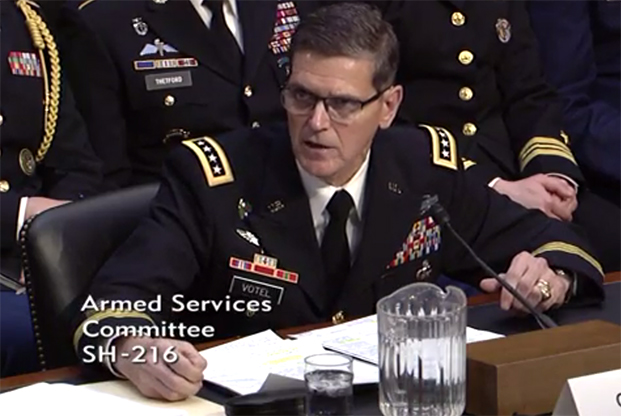
Gen. Joseph Votel, commander of US Central Command, testifies before the Senate Armed Services Committee on Feb. 5, 2019, in Washington. SASC screenshot.
US Central Command is exploring better ways to share its combat assets with neighboring geographic commands in response to the Pentagon’s growing focus on other advanced militaries instead of counterterrorism, according to CENTCOM’s top general.
In his likely final appearance before the Senate Armed Services Committee Feb. 5, Gen. Joseph Votel told lawmakers he supports the 2018 National Defense Strategy’s push to compete with Russia and China, and recognizes the US military’s presence in the Middle East will change as a result.
“As we go through the discussions and the planning aspects of that with the Joint Staff, with [the Office of the Secretary of Defense], and certainly with the services, we will seek to maintain the capabilities that we need to, and then ensure that we have the right response capabilities to address threats as they present themselves in this area,” the retiring Army four-star said.
Votel’s comments to freshman Sen. Josh Hawley (R-Mo.) also addressed a question Air Force Secretary Heather Wilson posed at the recent Reagan National Defense Forum in California: Can CENTCOM shrink its demand for combat resources
“Are we going to be able to reduce our level of effort against violent extremism? Is the combatant command going to be comfortable with lowering that level of commitment?” she asked during a panel discussion at the annual high-profile conference in December. “We cannot continue this high level of effort and get prepared for a high-level fight.”
If not specifically committing less, Votel indicated the command can at least be more responsive to the needs of military leaders in other regions.
“One of the areas where we can continue to be more efficient is how we operate along our seams, our bureaucratic combatant commander seams,” he continued. “I share a boundary with [US European Command] to the north, I share one with [US Africa Command] to the west, and with [US Indo-Pacific Command] to the east. I think it is extraordinarily important, as we look at managing resources, that we look at positioning and employing these resources in a way that they can be of the maximum utility to multiple combatant commands.”
The military already relies on shared assets in some instances, such as when AFRICOM offers basing options for CENTCOM’s activities on the Arabian Peninsula. But Votel believes the Pentagon can make further improvements, echoing the Defense Department’s broader vision of being able to rapidly deploy personnel and facilities as global combat needs evolve.
“I think there are some smarter ways of doing this,” he said. “Certainly the department’s focus on dynamic force employment, where we exercise strategic predictability but operational unpredictability, I think is a good concept of this, where we are able to move resources in a more agile fashion into areas where we see opportunities with this. I think this is another area that we need to continue to focus on.”
Votel has led US forces in the Middle East since 2016 and is leaving his post as the Pentagon prepares plans to withdraw from its major campaigns there at President Donald Trump’s request. This week, Votel emphasized local militaries need to continue pressuring terror organizations to prevent the remaining 20,000 to 30,000 Islamic State of Iraq and Syria members spread across the region from regaining territory. The same is true for Afghan security forces fighting the Taliban and other local groups.
Votel told SASC Chairman Jim Inhofe (R-Okla.) he believes ISIS will lose its remaining 20 square miles of territory by the time US troops leave, and the group will continue its attacks and try to regroup.
To counter that resurgence, the Defense Department wants to equip the area’s militaries with new aircraft without stressing their forces or driving them to shop from Russia or China instead. Votel pointed to the Air Force’s light-attack aircraft experimentation program—and the Sierra Nevada-Embraer team’s A-29 Super Tucano in particular—as a smart, albeit nascent investment.
“Being able to train our partners in terms of employing those things, I think, reduces the burden on us and it provides self-sufficiency for them,” he said of a light-attack platform. “It does it without creating a significant logistical burden. Whether it’s A-29s that we see with the Lebanese armed forces or A-29s that we see with the Afghan security, Air Force, these, I think, are good investments.”
Air Force officials have recently said the nearly three-year light-attack experimentation program, which was expected to result in a production contract this year, will now broaden from vetting the A-29 and Textron’s AT-6B Wolverine to potentially include drones, helicopters, or jets.
A Fiscal 2018 report published by the Pentagon’s director of operational test and evaluation last week noted that at one point, the Air Force intended to buy 359 single-engine turboprop aircraft for eight operational squadrons and three training units. Those plans are now on hold as the service continues experimenting.
Votel argued the US needs to revamp its foreign military sales rules to be more responsive to partners’ needs so they don’t buy war materials from America’s adversaries.
“We should try to steer them away from just buying things they can’t maintain, they can’t sustain, they can’t man long-term, and we should be focused on the equipment that they can—equipment that can be integrated with us and other partners in the region to provide a more formidable deterrent effect or a defense, if needed,” he said.
Votel also told lawmakers the US needs to continue funding Afghanistan’s security forces, part of the wider stabilization effort which the Special Inspector General for Afghanistan Reconstruction found has received about $84 billion since Fiscal 2002. The commander declined to say how much money he thinks the growing ground and air forces need to succeed.